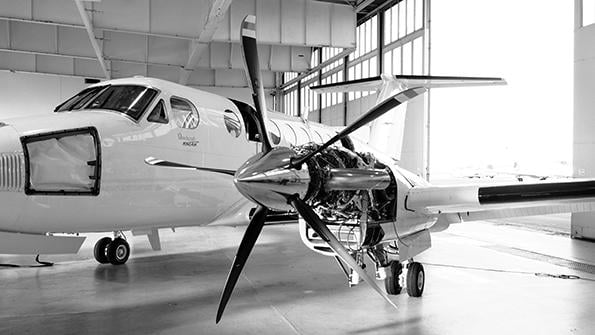
The Catalyst turboprop, GE Aviation’s new small-engine program, is entering the homestretch toward flight testing, certification and initial installation on Textron Aviation’s Cessna Denali turboprop single.
Delayed by more extensive certification requirements than originally expected and by pandemic-related disruption, the engine has taken longer to develop than GE envisaged when it first announced the program more than five years ago. The new turboprop, however, has now been installed and run on a modified Beechcraft 350 King Air in readiness for flight tests and is undergoing certification ground tests.
- Test engine is mounted on a King Air 350
- After core icing, IMI Is next for certification testing
As the first clean-sheet, all-new centerline turboprop in its class in five decades, the Catalyst has been subjected to stringent certification testing in new areas, such as critical ice core icing. “We just got through that core icing test in Canada, which was a very significant milestone for us,” says Paul Corkery, GE Aviation turboprops general manager. “A lot of things have changed since the last turboprop, so we’ve gone through a lot of testing and, in fact, have completed three of the certification tests now,” he adds.
Designed to compete principally with the Pratt & Whitney PT6, the Catalyst has been developed to provide a new-generation power source for general aviation and business aircraft applications, advanced military trainers, unmanned air vehicles and, potentially, hybrid-electric-powered cargo drones and air mobility vehicles.
The 850-1,650-shp-range engine has a 16:1 overall pressure ratio, four-stage axial single centrifugal compressor and several advanced features derived from GE’s larger commercial turbofans. These include a combined engine and propeller dual-channel, full-authority digital engine control (FADEC) system as well as two stages of variable-geometry compressor stator vanes.
“We have proven out that technology in the altitude chamber, and it gets us to the power and fuel burn we need at altitude. So the compressor is running well with the variable geometry,” Corkery says. At the turboprop’s heart is a two-stage high-pressure turbine (HPT) comprising 3D aerodynamically designed, single-crystal cooled blades. Describing the blades as a “real differentiator,” Corkery says the higher temperature capability of the HPT (about 300F greater than other turboprops) enables “the power that we need so that our lapse rate as we go up on horsepower to altitude is better,” he adds.
“We’ve done a lot of testing to validate not only the technology but the performance, so I feel very confident that we’ve met our targets of 15% better fuel burn and 10% better power across the altitude and the flight envelope [relative to similarly rated current engines],” Corkery says.

Apart from the early altitude-test chamber work, conducted in Canada in 2019, the Catalyst is a European-based development effort. GE Avio Aero in Italy is contributing design work and additively manufactured parts, while the focus for ground test and development is at the company’s Czech facilities near Prague. The engine program has required the use of six test cells, four of which are newly built and two are refurbished. “We have 11 engines running in and out of those test areas, and as we learn, we rebuild them. We have two more new builds coming through for the certification campaign, and they’re already in process,” he says.
Up next for the certification effort is the initial maintenance inspection (IMI) test, which establishes the maximum hours or cycles that an engine should be operated in service before a hardware serviceability inspection is conducted on static, rotating assemblies, systems and controls. “That’s a 2,000-cycle and 1,100-hr. evaluation, so that’s a big test,” Corkery says.
Flight testing is expected to follow in Berlin in the second quarter. The King Air 350, which was modified in Germany for flight testing by GE and the Czech Technical University Center of Aviation and Space Technology, has been outfitted with high-speed data-acquisition systems for its flying testbed role. The sophisticated modification has contributed to the delays, Corkery says. “The regulations that you have to go through and the complexity of doing that, especially in the EU, were a bigger challenge than we understood at that time.”
Although GE is “laser-focused” on supporting the start of flight tests on the Denali, the company is eager to exploit the wider potential of the Catalyst beyond traditional applications. One such area is the growing hybrid-electric market for cargo drones and advanced air mobility. “Hybrid is interesting to us,” Corkery says. “You take the propeller off the Catalyst and put on a permanent magnet generator, and you have got a 1-megawatt solution” (AW&ST April 5-18, p. 16).
“It fits very nicely in this class of aircraft because it is FADEC-equipped, which enables you to distribute the power and manage the engine as well,” Corkery says. “It’s also the performance- and the low fuel burn helps. This is in its infancy, but it’s going to ramp up exponentially, and technology-wise, we feel we’ve got a pretty good solution to work with different people.”





